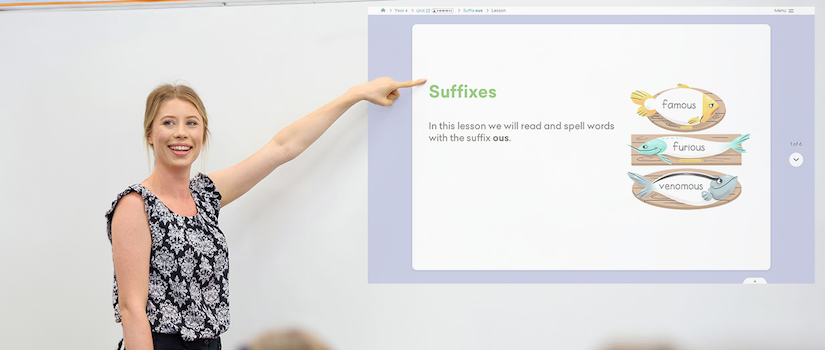Articles & Videos
Grattan Institute: 'Australia has a reading problem'
Categories
Subscribe to our newsletters
Receive teaching resources and tips, exclusive special offers, useful product information and more!
Back to Product Features articles & videos
Grattan Institute: 'Australia has a reading problem'
Sound Waves Literacy 12/4/24

In February 2024 the Grattan Institute published a report entitled The Reading Guarantee: How to give every child the best chance of success and it opened with a confronting fact: ’Australia has a reading problem. A third of our children can’t read proficiently.’ 1
Australia needs a reading revolution. Why?
The report attributes Australia’s poor reading results to a lack of evidence-based teaching. Specifically, it identifies two main approaches that have been used in classrooms that have contributed to the high percentage of struggling readers. The first is the whole language approach to reading, which was popular in the 1970s and still persists in many classrooms. And the second is the balanced literacy approach, which the report describes as ‘contrary to scientific recommendations’.
According to the report, a reading revolution is required to replace these ineffective practices with an evidence-informed structured literacy approach. Structured literacy involves the explicit teaching of essential skills, such as systematic synthetic phonics and phonemic awareness, that are necessary for developing proficient readers. Ensuring every student in Australia has access to best-practice teaching requires a commitment from governments, policymakers, teacher training institutions, school leaders and classroom teachers.
What is the Reading Guarantee?
The report recommends governments and school leaders commit to a 10-year, six-step Reading Guarantee as follows:
Step 1: Commit to at least 90% of students becoming proficient readers.
Step 2: Give teachers and school leaders specific guidelines on how to teach reading according to the evidence.
Step 3: Ensure schools have the high-quality curriculum materials and assessments teachers need to teach reading well.
Step 4: Require all schools to do universal screening of reading skills and help students falling behind to catch up.
Step 5: Ensure teachers have the knowledge and skills they need to teach reading well, through essential training and new quality-assured micro-credentials, and by creating specialist literacy teacher roles.
Step 6: Encourage best-practice teaching through closer monitoring and strengthened school performance reviews.
How does Sound Waves Literacy help students become proficient readers and spellers?
Sound Waves Literacy is a whole-school, evidence-informed program aligned with the Science of Reading. Designed to support best-practice literacy instruction, it employs a structured literacy approach that incorporates phonemic awareness, synthetic phonics, morphology and etymology. Sound Waves Literacy lessons follow the Gradual Release of Responsibility pedagogy, with explicit teaching and targeted consolidation for students.
As part of the structured program, the early years include a strong focus on beginning reading instruction. The Sound Waves Decodable Readers for Foundation and Year 1 ensure teachers can provide an engaging reading experience for beginning readers. Each book has been meticulously written within tightly controlled parameters that adhere to Sound Waves Literacy’s systematic synthetic phonics sequence. Once teachers have explicitly taught a phoneme–grapheme relationship, they use the corresponding projectable Decodable Reader for modelled and shared reading. Students then use the class sets of the books for independent reading practice. This allows students to apply the phoneme–grapheme knowledge learnt in the corresponding lessons directly to reading continuous, meaningful texts. Over time, this leads to rapid and accurate word recognition and improves reading fluency.
What’s more the books are available in three levels of difficulty (Support, Core and Extended) so every student can achieve reading success.
What curriculum and assessment material is provided with Sound Waves Literacy?
Teachers are thoroughly supported with planning documents, including:
Scope and Sequence F–6
Australian Curriculum Match F–6
Victorian Curriculum Match F–6
NSW Syllabus Match Early Stage 1
NSW Syllabus Match Stage 1
NSW Syllabus Match Stage 2
NSW Syllabus Match Stage 3
Sound Waves Literacy also includes an extensive set of reading and spelling assessments to monitor students’ progress. The assessment resources include clear instructions for implementing each type of assessment, along with spreadsheets or recording sheets for results. Remediation resources are also available so teachers can provide targeted remediation to students who require additional support.
What support is provided to teachers implementing Sound Waves Literacy?
To ensure the program is effectively implemented across your whole school, free professional learning and ongoing support is provided by a team of highly experienced education consultants.
The consultants provide a range of tailored professional learning opportunities to continually support you and your school. This includes implementation and refresher workshops, or more targeted sessions on using Sound Waves in the early years.
Head to our website to request a workshop for your school, register for a virtual workshop, browse the professional learning articles or simply reach out to your local education consultant at any time of the year with your questions.
Reference
- Hunter, J, Stobart, A, Haywood, A 2024, The Reading Guarantee: How to give every child the best chance of success, Report, Grattan Institute, viewed 12 February 2024. https://grattan.edu.au/wp-content/uploads/2024/02/The-Reading-Guarantee-Grattan-Institute-Report.pdf↩